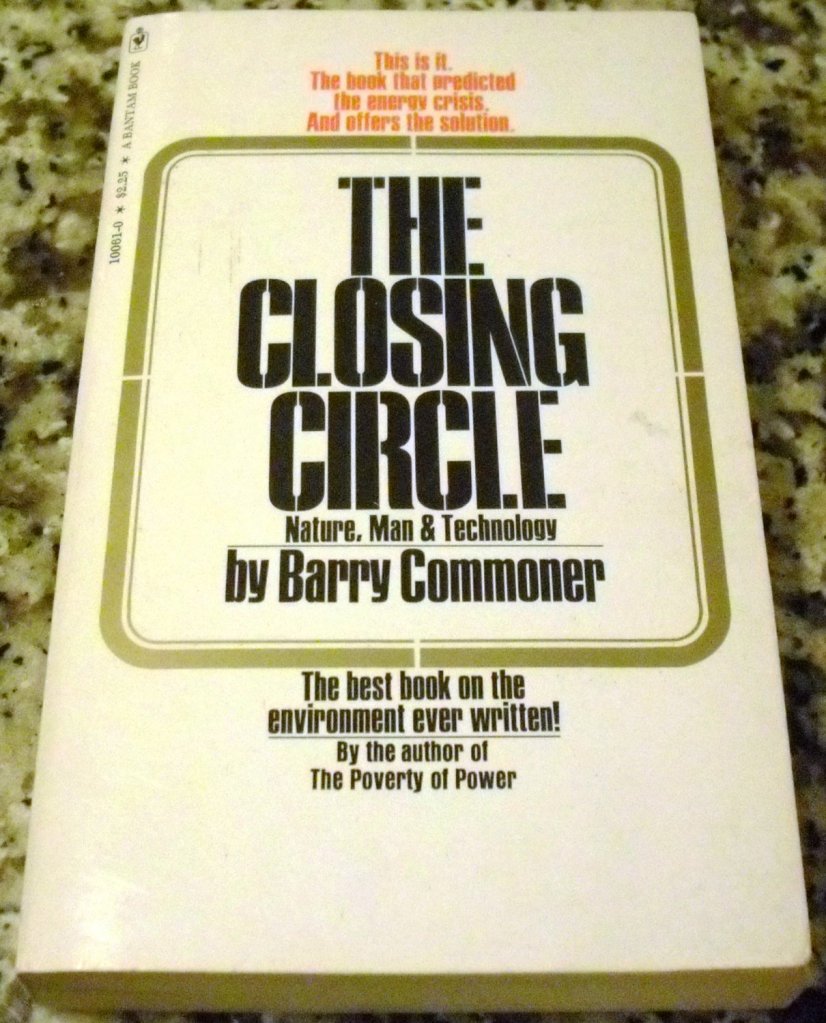In the previous two posts, I reviewed Santa Cruz County Governance and Environmental Plans, General Plans and Strategic Plans, the mishmash of rules and regulations by which humans attempt to order the human built world. Unfortunately, human social organization largely disregards the non-human world, other than as a source of “free” resources.
This results in a fatal disregard for the physical laws and natural processes that order the entire Universe, including the human built world, a subset of the natural world.
The science of ecology is the study of living beings and their connections to their physical environment. Though these relationships are often portrayed as applying only to other than human species, humans and the human built world are inextricably entwined in the Natural World and its relationships and processes.
In The Closing Circle, Nature, Man & Technology, 1971, ecologist Barry Commoner summarized these relationships in four “Laws of Ecology”:
Everything is connected to everything else – ecosystems are complex and interconnected. “The system,” Commoner writes, “is stabilized by its dynamic self-compensating properties; these same properties, if overstressed, can lead to a dramatic collapse.” Further, “the ecological system is an amplifier, so that a small perturbation in one place may have large, distant, long-delayed effects elsewhere.”
Everything must go somewhere – there is no ultimate waste in the natural world, matter and energy are preserved, and the waste produced in one ecological process is recycled in another. For instance, a downed tree or log in an old-growth forest is a life source for numerous species and an essential part of the ecosystem. Likewise, animals excrete carbon dioxide into the air and organic compounds into the soil, which helps sustain plants upon which animals will feed.
Nature knows best – “holds that any major man-made change in a natural system is likely to be detrimental to that system.” “The absence of a particular substance from nature,” Commoner writes, “is often a sign that it is incompatible with the chemistry of life.”
There is no such thing as a free lunch – “In a way,” writes Dr. Commoner, “this ecological law embodies the three previous laws. Because the global ecosystem is a connected whole, in which nothing can be lost or gained and which is not subject to overall improvement, anything extracted from it by human effort must be replaced. Payment of this price cannot be avoided; it can only be delayed. The present environmental crisis is a warning that we have delayed nearly too long.”
Though these observations seem self-evident, they have been ignored over the past 10,000 years by humans intent on material “progress,” if that’s what it is, exploitation of finite resources, and extirpation of non-human species in futile attempts to control Nature to support exclusive human growth and expansion.
We humans are coming face to face with the inescapable reality of natural limits to human growth and consumption. If we are to survive as a species, in company with the remaining species we have yet to extirpate, we must find ways to live in harmony in the natural world. Humans are not, despite current trends to the contrary, destined by genetics to live as exploiters and destroyers of the natural world. Many cultures lived for centuries in close harmony with others species of plants and animals on which they depended. A few have survived the onslaught of civilization, though dwindling rapidly.
In my web site The Way of Nature, I explore alternative historic and contemporary ways of viewing Life, the Universe and Everything, and the place of human societies and cultures in the natural world.
“In the year 9595
I’m kinda wonderin’, if man is gonna be alive
He’s taken everything this old earth can give
And he ain’t put back nothing
Woah-oh” Zager And Evans – In The Year 2525,
If man is gonna be alive, and woman too, we’re going to have to find a Way of scaling back this runaway train of civilization, and relearn how to Live in the Natural World.
Next up: How do we live in a world of Natural Laws in our own bioregion?
Discover more from We Live in the Natural World
Subscribe to get the latest posts sent to your email.

Thank you Michael!
I appreciate your highlighting these “older” works to remind us that we knew then that burning petroleum was deadly. As kids we would cough up the acrid smog pouring from our surf wagons.
And I just posted about 3M covering up the pervasive spread of forever chemicals to all bodies
“Look at Mother Nature on the run in the 1970s”
And thanks for your publicizing all local municipal dealings.
Andy Carman
Environteers.orghttp://Environteers.org
LikeLike
Thanks Andy!
I’ll be working on a bibliography, largely sourced from our own home library, of those works from the 60s and 70s which contain all we need to know about living in the Natural World.
LikeLike
Michael,
I tried to comment on your post, but I got an error message providing that it was a duplicate comment. I get these often in this system (WordPress?) and it’s BS, but there’s nothing I can do about it. I’ve found that Disqus is by far the best system for commenting on posts, never have any problems with it for one thing. Anyway, here’s my comment:
I’m glad that you listed human behavior for the past 10,000 years and civilization as the problems. Most environmentalists start after humans were already causing the problems and focus on symptoms like global warming/climate change instead of these root causes. Pollution is a mere symptom, not a root cause, to list just one example. Physical root causes are things like agriculture, human overpopulation, and overconsumption/wrongful lifestyles. The real root causes are mental and spiritual of course.
LikeLike
Right on!
LikeLike